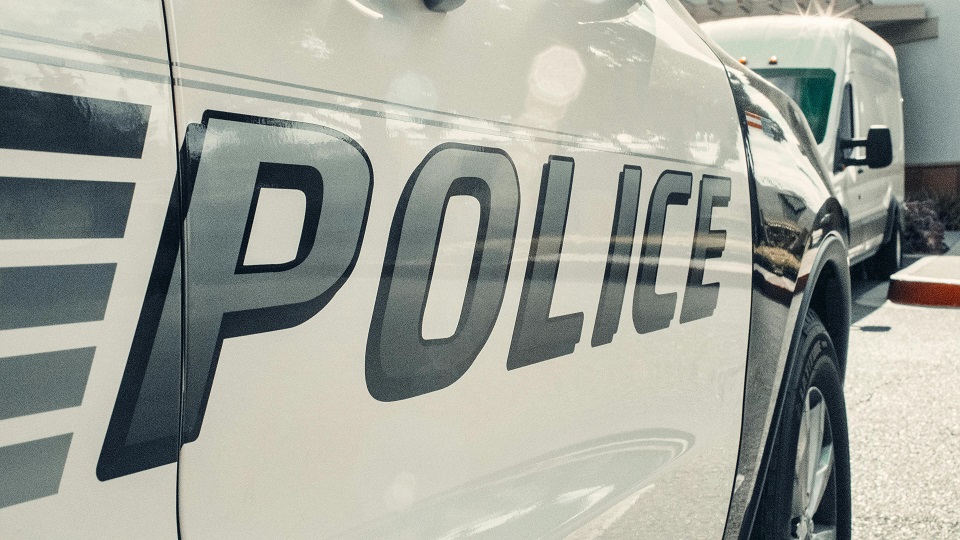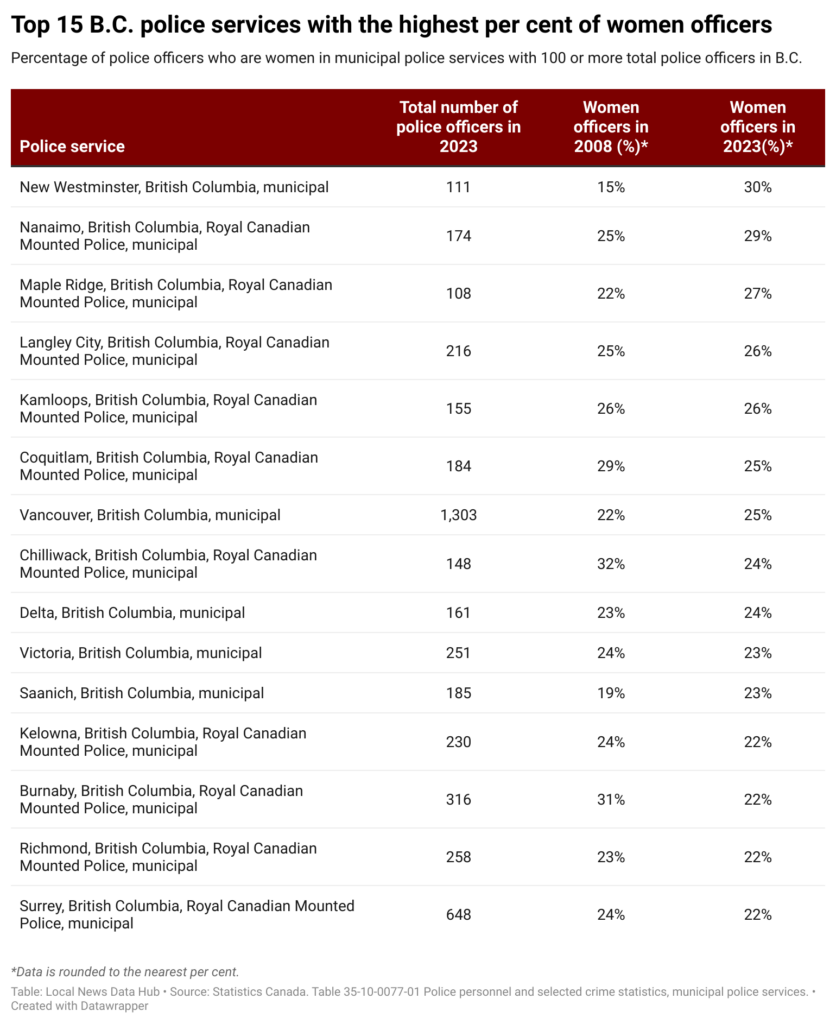
B.C.’s largest police services still don’t have enough women officers to change a male-dominated work culture, analysis shows
More women are needed to break up the “boys’ club”

By Apurva Bhat and Carly Penrose
Local News Data Hub
Feb. 11, 2025
Women police officers remain significantly underrepresented in police services across British Columbia despite evidence suggesting they are often preferred by victims of domestic violence or sexual assault, are less likely to use force, and may be better at de-escalating tense situations.
Among the 19 local police services in the province with 100 or more officers in 2023, gender diversity was greatest in the New Westminster Police Department, according to a new analysis by the Local News Data Hub at Toronto Metropolitan University. Women made up 30 per cent of the 111 uniformed frontline and senior officers who comprise the sworn ranks. The next best performer was the RCMP detachment responsible for local policing in Nanaimo, where 29 per cent of sworn officers were women.
The 30×30 Initiative, a coalition of Canadian and American police agencies and researchers that supports the advancement of women in policing, suggests a group must make up at least 30 per cent of an organization before it can influence its culture.
The underwhelming results of efforts to recruit and retain women in the field come at a time when many argue they are essential to effective policing.
Michelle Davey, deputy chief of the Delta Police Department, said the job is about more than just nabbing criminals: “(Officers) have to wear 15 different hats to either apprehend a child, find a missing elderly person, resolve a neighbor dispute where both of them have mental health issues.”
Davey, who has spent nearly three decades in policing, said women are “better versed at communication than men, so we can talk our way through and around a whole bunch of things way before having to use force.”
A study by Carleton University researchers that examined the use of force at one large Canadian police service concluded that its women officers were about half as likely as their male counterparts to ever employ force.
Despite the significant strengths they bring to the job, Davey said policing is “still a tough culture to be in as a woman.” Some male colleagues are welcoming and inclusive, she said, but she has also been in situations with “male leaders where I’m talked over, I am dismissed.” In 2023, 24 per cent or 39 of the 161 sworn officers in the Delta Police Department were women, up only slightly from 23 per cent in 2008.
After identifying the 75 local police departments in Canada with 100 or more sworn officers in 2023, the Data Hub ranked them based on the percentage of women in each service. Across the country, only nine met or surpassed the 30 per cent threshold for gender representation.
The analysis used personnel data submitted annually by municipal police services to Statistics Canada’s Police Administration Survey. Brianna Jaffray, from the Canadian Center for Justice and Community Safety Statistics at Statistics Canada, confirmed that comparing the survey’s personnel data across jurisdictions and over time was a valid approach. The data also showed that:
- Overall, 23 per cent of sworn officers across Canada were women in 2023, up from four per cent in 1986 when Statistics Canada began collecting data.
- Montreal’s police service had the highest proportion of women officers in its sworn ranks – they accounted for 35 per cent of its 4,507 officers in 2023.
- The New Westminster Police Department placed eighth out of 75 in the national ranking, while Nanaimo was 11th. The Vancouver Police Department, where women comprise about a quarter of the service’s 1,303 sworn officers, ranked 24th.
- The poorest performing police service in British Columbia was the RCMP-run police jurisdiction in the Lower Mainland District, located in the province’s southwest corner. With women making up 16 per cent of officers, it ranked 68th out of 75.
- Eight police services in British Columbia experienced a decline in the proportion of women officers over time: For instance, in Burnaby, where the RCMP is responsible for local policing, only 22 per cent of sworn officers were women in 2023, down from 31 per cent in 2008.
The Delta Police Department, Saanich Police Department and Surrey Police Service are among just eight Canadian members of the 30×30 Initiative, which says the “under-representation of women in policing undermines public safety.” Signatories commit to increasing women’s representation among police recruits to 30 per cent by 2030.
Carrie Sanders, a Wilfrid Laurier University criminology professor and co-author of a study that examined how women navigate the “boys’ club” mentality in policing, said in an interview that integrating women isn’t just about boosting numbers. “It’s about creating a cultural space of inclusion that allows the women to do well and flourish.”
The research team interviewed 91 women, most of them sworn officers, and Sanders said participants frequently mentioned having to deal with “sexual innuendos being made on the job, or statements that no one should be expected to have to listen to or learn to laugh off, in order to feel like they’re just part of the club.”
The study, published in a 2022 issue of Feminist Criminology, includes one officer’s description of being left alone to de-escalate a situation. Her backup said he wanted “to make sure you can handle yourself, be one of us.” Another interview subject observed that “you’re a member of the brotherhood unless you challenge the men.” Researchers also heard that being accepted into the boy’s club meant “not be(ing) as friendly to the other women.”
Recent history suggests changing police culture remains a work in progress for many services. Six women police officers in British Columbia, for instance, have named 13 cities with municipal police services in a proposed class action lawsuit that claims discrimination and harassment based on gender.
And a 2020 report that reviewed the treatment of women in the RCMP, which is contracted to provide local policing in more than 150 Canadian communities, concluded its culture was “toxic” and “tolerates misogyny and homophobia at all ranks and in all provinces and territories.” The report was part of a $125.4-million class action settlement with more than 2,300 women RCMP officers and civilian employees who experienced workplace gender and sexual orientation harassment and discrimination between 1974 and 2017.
Davey suggested other reasons women rule out careers in policing. Some don’t see it as an option because it has traditionally been a male-dominated occupation, she said. Others are put off by the high levels of public scrutiny and police oversight. “You have to have pretty thick skin to go through numerous investigations on your actions, it’s not for everybody.”
Shift work was also on her list of deterrents: “It’s pretty difficult to raise your children if you’re working two days and two nights in your shift work pattern,” she observed.
Finally, she said in an email that potential candidates may be discouraged by physical tests that she argues are “no longer reflective of the physical demands of modern-day policing.” It would make more sense, she wrote, to test candidates’ overall cardiovascular and strength fitness when they apply and then train them for job-specific physical tasks after they are hired.
The top-ranked Montreal police service, which boosted the number of women in its sworn ranks to 35 per cent in 2023 from just under 30 per cent in 2008, aims to attract recruits by highlighting successful women role models, Rose-Andrée Hubbard said in a written statement translated from French.
Hubbard, the Montreal service’s equity, diversity and inclusion advisor, said the department visits schools to promote policing careers for women and hosts recruitment events where the benefits and challenges of being a woman officer are openly discussed.
Other best practices identified by researchers include recruiting from more than just criminal justice-focused college and university programs, highlighting educational and professional development opportunities, and putting in place on-site childcare and other family-friendly policies such as job sharing, part-time work and more flexible shift work.

This story was produced by the Local News Data Hub, a project of the Local News Research Project at Toronto Metropolitan University’s School of Journalism, with support from the Investigative Journalism Foundation. The Canadian Press is the Data Hub’s operational partner. Detailed information on the data and methodology can be found here.